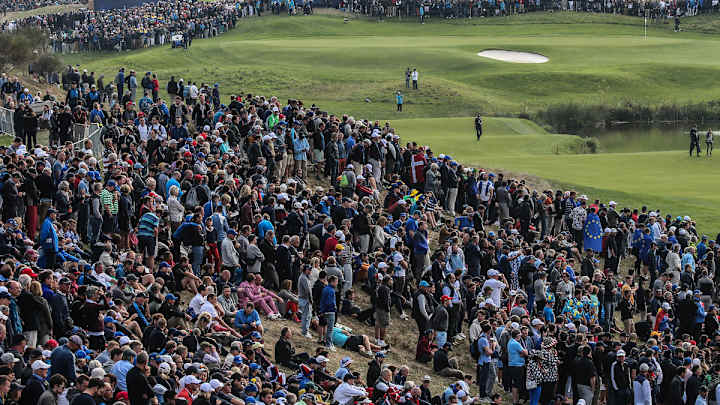Why PGA Tour will be just fine, with or without fans

If you’ve spent any amount of time watching Golf Channel – and it’s probably a fair assessment to think you have – the idea of playing PGA Tour events without spectators hardly is a novel concept. At the 2018 WGC gathering in China, for instance, there wasn’t a patron to be seen until the 18th green, despite Sunday’s marquee final grouping of Tony Finau, Justin Rose and Xander Schauffele.

Tour officials wisely planned to hold a prospective playoff on the par-5 finisher, where Schauffele beat Finau on the first extra hole. Those still loitering in the grandstands were not required to wear medical masks during the trophy ceremony.
In sickness and in health, the world’s best players do not always draw a crowd. When the WGC series began in 1999, attendance at the Match Play was unfathomably weak. The tournament was moved to a mountain in Arizona eight years later – and the galleries got even smaller. Actually, you really couldn’t call them galleries. It was an isolated case of people standing within close proximity of one another, long before social distancing became a fashionable means of survival.
So, here we are. Together but separate, divided yet united, waiting for planet earth to get back on its feet and for pro golf to pick up where it left off. How long will the Tour stage events under its recently announced spectator embargo? Throw a dart at a calendar, hombre. The term until further notice already has logged a ton of mileage in 2020, but until further notice, not even those with 20/20 vision can answer that one.
Seriously? The fan ban is no big deal, at least for a month or three. If 30,000 people would have shown up at Colonial Country Club to witness June’s supposed restart in Fort Worth, perhaps 3 million will view it on TV. Maybe half that number would have bothered to watch under normal circumstances, but for now, Camp Ponte Vedra is the clubhouse leader in terms of hosting a live sporting event. An abnormal amount of eyeballs will be focused on what could be a very weak field, so it would be nice if a few of the world’s best golfers hopped into their private jets and made the trip to Texas for curiosity’s sake.
Where’s Annika Sorenstam when you really need her?
It’s worth mentioning that tour pros weren’t actually tour pros until they got really good. They played a whole bunch of golf when nobody was there to watch as they scaled the ladder to excellence. Some probably didn’t perform in front of a big crowd until they began playing for a living. Come to think of it, some still haven’t.
Tom Lehman’s older brother Jim is a terrific player, a decorated amateur with a nice pile of USGA appearances to prove it, although my wallet also can attest to the man’s game. I once asked Jim about the difference between himself and his so-called little bro. “We might go out for a casual round and we’ll both shoot a 69,” he said. “But if you put 5,000 people around every hole, I’ll shoot a 75. Tom will shoot a 68.”
Understood. I covered the 1992 Kemper Open, in which Washington Redskins quarterback Mark Rypien became the first active pro athlete from another sport to participate in a Tour event on a sponsor exemption. I had played with Rypien a few weeks earlier. Like a lot of broad-shouldered jocks toting a low handicap, he could hit the ball a mile and then some, but his short game bore virtually no resemblance to that of a man who doesn’t get paid unless he gets up and down.
The reigning Super Bowl MVP shot 80-91. “There were people lined up three-deep on every fairway,” Rypien said. “I was scared I was going to kill someone.”
Public safety has warranted a more realistic urgency in these trying times. An overwhelming majority of Americans (more than 70 percent) have said they aren’t comfortable attending large-group gatherings, be it a baseball game or a bar mitzvah. That survey was conducted by Seton Hall University, leaving one to wonder why a mere 762 participants were polled. Maybe everyone was hiding inside.
Golf has a couple of things working in its favor when it comes to letting fans back in the ballgame. The biggest is that there’s no contained dwelling such as a stadium or arena, as is the case in other sports. In lieu of grandstands, people attending tournaments later this year could be forced to spend the afternoon navigating 200 or so acres of God’s green earth. If they’re not careful, they just might get a little exercise.
We probably should expect very limited ticket sales at first, then a gradual increase as coronavirus begins to relinquish its stranglehold on society, which takes us to the year’s three remaining majors. The PGA Championship is still 3½ months away, perhaps a viable over/under as to when spectator restrictions might be lifted. It’s one thing to hold an RBC Heritage or Rocket Mortgage Classic in a bubble, but a U.S. Open or Masters?
It just wouldn’t be the same, and that would be a shame. The vibrant atmosphere at golf’s biggest and most important gatherings is a huge part of what makes attending those events so special. It’s like going to a festival or an outdoor concert, but instead of observing fall-down drunks and allowing some heavy-metal band to pillage your eardrums, the sights and sounds are infinitely more appealing.
The roar of the crowd. The chatter of thousands. The unmistakable beauty of genuine applause. A golf tournament is a very cool thing. The folks without clubs in their hands are a big reason why.
Sign up to receive the Morning Read newsletter, along with Where To Golf Next and The Equipment Insider.
